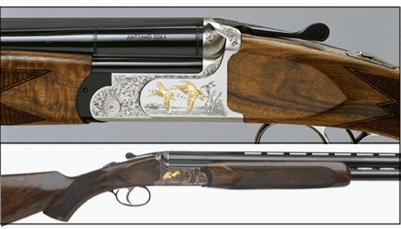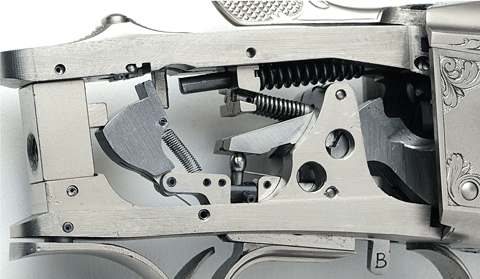Shooting 100 rounds of sporting clays with the new Caesar Guerini Apex is best summed up by how the gun performed on the last station: I crushed a pair of teals with a single shot.
Even my shooting partners, made up of Blaser F3 and Beretta owners, were impressed with the incredible target-crushing power of the Guerini Apex. Like so many other shooters who appreciate fine shotguns, they heard the advanced buzz over the Guerini Apex but never had the privilege of actually seeing one in action.
These highly coveted shotguns have been in short supply since their introduction at the 2009 Shot Show, held January 15-18 in Orlando, Florida. Recently, shipments of the new Guerini Apex have started trickling into the U.S. from the factory in Brescia, Italy.
I managed to get one of the few Guerini Apex Sporting Models on the sporting clays course thanks to Bart’s Sports World in Glen Burnie, Maryland. The three Bart brothers – Jack, Wayne and Roy – live close to Caesar Guerini’s U.S. headquarters in Cambridge, Maryland. In fact, one morning I called over there Wayne was making his usual rounds on behalf of his customers.
The Guerini Apex is a premium shotgun. It ranks under Guerini’s most expensive Forum in the Caesar Guerini lineup. Although the Guerini Apex is not the top model, it exudes a transcendental vibe unlike any Caesar Guerini I’ve ever shot.

A round of sporting clays with the Guerini Apex delivers an epiphany by defining the benchmark for a $7,500 shotgun. The Guerini Apex makes you feel like every target moves in slow motion and is simply there to be pulverized.
I put the Guerini Apex through its paces at Schrader’s Bridgetown Manor, in Henderson, on Maryland’s fabled Eastern Shore. Schrader’s is known locally for its challenging course. The stations are in wooded surroundings, with mottled sunlight and plenty of natural obstacles. Schrader’s rabbit targets seem to be powered by afterburners and bounce like they are cam-shaped. Schrader’s outgoing targets tend to be slower than at other courses, but far more acrobatic and elusive as they seek the trees.
I shot 100 rounds with Roy Bart, Bart’s store manager, Al Koch and three of their shooting buddies. Wednesday mornings at Schrader’s is a weekly ritual for them, followed by lunch at the Batter Up in nearby Ridgely, and then perhaps a second round of sporting clays at Schrader’s.
The Guerini Apex I shot possessed every attribute that sets the gun apart from the other Caesar Guerini shotguns, except that for some odd reason this one had arrived from Italy with standard quality wood uncharacteristic of the figured, hand-rubbed walnut you should expect. So rather than upgrade the wood, it was turned into a demo gun. That said, it displayed a flawless wood-to-metal finish and everything about this particular Guerini Apex was a testament to quality craftsmanship.
The 32-inch over/under barrels and Prince of Wales-style forend all fit into place with no trauma or struggle. The two IC chokes screwed in effortlessly even though the threads had never been touched by oil. I then grabbed four boxes of Estate #8, 1-ounce loads and was ready to shoot.
Since Shotgun Life was the first publication to cover the Guerini Apex prior to its unveiling at the January 2009 Shot Show, it was nice to also be the first to write about actually using the gun.
In my visit to Caesar Guerini prior to the Shot Show, I had spent about two hours with Wes Lang, president of the company. Wes had filled me in about what to expect on the Guerini Apex, but no gun was available for me to handle.
Now, all of that has changed…
Although the Guerini Apex shares the actions, barrels and accessories with other Caesar Guerini shotguns, it benefits from new high-tech applications that we’ll probably see in future enhancements to the Caesar Guerini family.
The Guerini Apex combines laser, EDM (electrical discharge machine) hand engraving and other techniques to yield deep, elaborate patterns on the full sideplates. In the case of the Guerini Apex, the results are a stunning marriage of floral and scroll patterns with gold details on a polished coin finish. The full coverage of the engraving continues beyond the frame to the trigger guard, extended tang and forend hardware.
By using trunnions instead of hinge pins, and a “blind” sideplate mounting, Caesar Guerini receivers are free of the visible screws and hinges that can detract from the engraver’s art. That’s why the Guerini Apex can present a museum-quality sideplate on a shotgun that starts for under $10,000.
The integrity of design also extends to a trigger guard that eliminates screws, as it joins seamlessly with the elongated tang devoid of screws, which dovetails into a skeletal grip cap fastened by two screws. In effect, it’s a minimalist industrial rendition of an old-world, best gun approach.
The continuous ribbon of engraved metal from the trigger guard to grip cap creates an elegant line through the swept-back pistol grip. The stunning cosmetics are more than skin deep. As I discovered, the motif also gives the shooter a smooth, ergonomic grip that enhances the shotgun’s handling.

Caesar Guerini Apex Tale of the Tape |
Gauge | 12 |
Barrel length | 30”, 32”, 34” |
Avg. Weight* | 7lbs. 14oz. – 8lbs. 4ozs |
Receiver finish | Coin finish, urethane coated |
Stock Finish | Hand rubbed oil |
Checkering | 26 lines per inch |
Recoil Pad | Black rubber |
Chamber | 2.75″ |
Top Rib | 10mm (.4”) Parallel |
Center Rib | Ventilated |
Forcing Cones | 5” DuoCon |
Avg. Barrel Weight | 30” (3.28lbs), 32” (3.35lbs.), 34” (3.44lbs.) ** |
Avg. Bore | .735, Chrome lined |
Chokes | 6 MAXIS competition chokes |
Sight(s) | White Bradley style front, brass center bead |
Fore-end | Rounded |
Trigger | Single selective, adjustable for length of pull |
Safety | Manual (Automatic as an option) |
Accessories | Stock and trigger wrench, choke case, friction choke wrench. |
Case | Plastic and leather hard case with fit interior. Source: Caesar Guerini |
* Weight may vary based on wood density.
** Special order only through the Caesar Guerini Custom Shop
Mind you, the feel of the Guerini Apex won’t be mistaken for a round-body FAMARS Excalibur, but I will say that in a blind test the Guerini Apex would probably emerge as the most comfortable shotgun among its peers.
Out on the sporting clays course, one of my immediate reactions to shooting the Guerini Apex was how sturdy it felt. The Caesar Guerini boxlock actions are machined from solid billets of steel and alloys. This process provides both stronger actions and better recoil absorption. That’s one of the reasons why shooting 100 rounds of 1-ounce loads never bothered me.
The inertia trigger group on the Guerini Apex felt crisp enough that it contributed to a more aggressive and confident shooting style. Caesar Guerini’s triggers are designed for reduced friction. Marry that with the inspiring ergonomics of the Guerini Apex and the gun seemed hard-wired to my brain for nailing that critical point of impact in the more difficult presentations at Schrader’s.
One particular station featured a simo-pair consisting of a fast quartering away bird flying straight for the trees, followed by a much slower looper suddenly popping out from a bush about 15 feet in front of me before plunging into tall weeds.
Instinct dictates that you go after the fast quartering away bird, thinking that the slower looper would be the natural second shot. That wasn’t the case. It took a lot of patience and gun control to wait for that looper to finally appear, smash it first, then track the quartering away bird as it transitioned into a low, fast, 20-yard shot.
The new Prince of Wales-style forend on the Guerini Apex gave me the superior control in a shot that demanded a combination of nerve-wracking patience followed by a burst of speed.
Making its debut at Caesar Guerini, the Prince of Wales-style forend replaces the Schnabel forend on other Caesar Guerini models. In comparison to a Schnabel forend, the Prince of Wales-style forend tapers toward the muzzle and eliminates the lip on the leading edge of the forend to create a more organic contour.
Like forends on other Caesar Guerinis, the Guerini Apex features an Anson pushrod forend latch. It appears as a small button on the nose of the forend. It’s recognized for three significant benefits: By eliminating the big external latch used by most other gunmakers, the checkering can wrap completely around the forend for a more secure grip. In addition, it’s self-adjusting over time. Finally, there are fewer working parts to deteriorate.
The payoff of this beautiful forend is a steady left hand in waiting for a slow looper plus the effortless handling in establishing and crushing the second, faster quartering away bird.
As we made our way through the sporting clays course, it became increasingly obvious that the Guerini Apex was an extraordinary shotgun. My squad-mates repeatedly praised some of the more difficult shots I had made with it. But for me, it was a shot made by Al that truly opened my eyes to the gun’s superiority.
We were at a station where rising outgoers were thrown from a hand trap: two reports followed by a simo pair. They were pretty much lay-ups, but for whatever reason Al missed one bird in the simo pair. After we had all shot, Al asked the trapper to throw him another simo. Al totally crushed the birds and I immediately thought, wow, I hadn’t seen Al hit targets that hard all morning. When Al turned around he raised the Guerini Apex in a triumphant thrust. Until that point, I had no idea he was using it for that shot.
What was it about the Guerini Apex that made it feel so special?
I will say that the Guerini Apex I used felt more balanced than the other 12-gauge Caesar Guerinis I’ve shot. It could have been the density of the wood or any combination of factors, but the gun performed as though all the incremental improvements made to the Caesar Guerini family of shotguns had been unified in the Guerini Apex. There’s a sense that the Guerini Apex is the culmination of the entire Caesar Guerini aesthetic and philosophy.
Its perfect center of gravity, clean elegance of the design and that touch of Italian magic gave the Guerini Apex the authority and poise rarely found in a production shotgun for under $10,000.
If you’re interested in a Guerini Apex, the manufacturer’s suggested retail price is $7,550. Standard options include $200 for a left-hand stock and $120 for an English Stock.
You can also consign your Guerini Apex to the company’s new Custom Shop for upgrades such as the D.T.S Kinetic Balancer, custom engraving, bespoke stocks, adjustable recoil pads or anything else a proud new owner could desire.
Irwin Greenstein is Publisher of Shotgun Life. You can contact him at
letters@shotgunlife.com.
Useful resources:
http://www.gueriniusa.com
http://www.bartssports.com
http://www.schradershunting.com
{loadposition signup}












